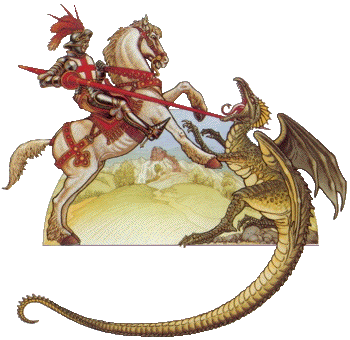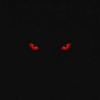← Mentorships

Morphology
A dragon is a mythological representation of a reptile. In antiquity, dragons were mostly envisaged as serpents, but since the Middle Ages, it has become common to depict them with legs, resembling a lizard. Dragons are usually shown in modern times with a body like a huge lizard, or a snake with two pairs of lizard-type legs, and able to emit fire from their mouths. The European dragon has bat-like wings growing from its back. A dragon-like creature with wings but only a single pair of legs is known as a wyvern.
Comparative mythology
The association of the serpent with a monstrous opponent overcome by a heroic deity has its roots in the mythology of the Ancient Near East, including Canaanite (Hebrew, Ugaritic), Hittite and Mesopotamian. Humbaba, the fire-breathing dragon-fanged beast first described in the Epic of Gilgamesh is sometimes described as a dragon with Gilgamesh playing the part of dragon-slayer. The legless serpent (Chaoskampf) motif entered Greek mythology and ultimately Christian mythology, although the serpent motif may already be part of prehistoric Indo-European mythology as well, based on comparative evidence of Indic and Germanic material.
Saint George Killing the Dragon, 1434/35, by Martorell
Although dragons occur in many legends around the world, different cultures have varying stories about monsters that have been grouped together under the dragon label. Some dragons are said to breathe fire or to be poisonous, such as in the Old English poem Beowulf.[3] They are commonly portrayed as serpentine or reptilian, hatching from eggs and possessing typically scaly or feathered bodies. They are sometimes portrayed as hoarding treasure. Some myths portray them with a row of dorsal spines. European dragons are more often winged, while Chinese dragons resemble large snakes. Dragons can have a variable number of legs: none, two, four, or more when it comes to early European literature.
Saint George and the Dragon

Dragons are often held to have major spiritual significance in various religions and cultures around the world. In many Asian cultures dragons were, and in some cultures still are, revered as representative of the primal forces of nature, religion and the universe. They are associated with wisdom—often said to be wiser than humans—and longevity. They are commonly said to possess some form of magic or other supernatural power, and are often associated with wells, rain, and rivers. In some cultures, they are also said to be capable of human speech. In some traditions dragons are said to have taught humans to talk.
The Order of the Dragon was created to defend Europe against the invading Ottoman Turks in the 15th century. Narratives about dragons often involve them being killed by a hero. This topos can be traced to the Chaoskampf of the mythology of the Ancient Near East (e.g. Hadad vs. Yam, Marduk vs. Tiamat, Teshub vs. Illuyanka, etc.; the Biblical Leviathan presumably reflects a corresponding opponent of an early version of Yahweh). The motif is continued in Greek Apollo, and the early Christian narratives about Archangel Michael and Saint George. The slaying of Vrtra by Indra in the Rigveda also belongs in this category. The theme survives into medieval legend and folklore, with dragon slayers such as Beowulf, Sigurd, Tristan, Margaret the Virgin, Heinrich von Winkelried, Dobrynya Nikitich, Skuba Dratewka/Krakus. In Biblical myth, the archetype is alluded to in the descendants of Adam crushing the head of the Serpent, and in Christian mythology, this was interpreted as corresponding to Christ as the "New Adam" crushing the Devil.
The blood of a slain dragon is depicted as either beneficent or as poisonous in medieval legend and literary fiction. In German legend, dragon blood has the power to render invincible skin or armor bathed in it, as is the case with Siegfried's skin or Ortnit's armor. In the Slavic myth, the Earth refuses it as it is so vile that Mother Earth wishes not to have it within her womb, and it remains above ground for all eternity. The blood of the dragon in Beowulf has acidic qualities, allowing it to seep through iron. Heinrich von Winkelried dies after the blood of the dragon slain by him accidentally drips on him.
Greek mythology
In Ancient Greece the first mention of a "dragon" is derived from the Iliad where Agamemnon is described as having a blue dragon motif on his sword belt and an emblem of a three-headed dragon on his breast plate.[4] However, the Greek word used (δράκων drákōn, genitive δράκοντοϛ drákontos) could also mean "snake".
In 217 AD, Flavius Philostratus (Greek: Φλάβιος Φιλόστρατος)[5] discussed dragons (δράκων, drákōn) in India in The Life of Apollonius of Tyana (II,17 and III,6–8). The Loeb Classical Library translation (by F.C. Conybeare) mentions (III,7) that "In most respects the tusks resemble the largest swine's, but they are slighter in build and twisted, and have a point as unabraded as sharks' teeth."
According to a collection of books by Claudius Aelianus (Greek: Κλαύδιος Αἰλιανός)[6] called On Animals, Ethiopia was inhabited by a species of dragon that hunted elephants. It could grow to a length of 180 feet (55 m) and had a lifespan rivaling that of the most enduring of animals.[7]
European dragon, Saint George and the Dragon, Margaret the Virgin and Dacian Draco
European dragons exist in folklore and mythology among the overlapping cultures of Europe. Dragons are generally depicted as living in rivers or having an underground lair or cave.[8] They are commonly described as having hard or armoured hide, and are rarely described as flying, despite often being depicted with wings. European dragons are usually depicted as malevolent under Christianity; pre-Christian dragons, such as Y Ddraig Goch, The Red Dragon of Wales, are seen as benevolent
The Red Dragon of Wales,

"Dragon Family" in Varna, Bulgaria.

In Slavic mythology, the words "zmey", "zmiy" or "zmaj" are used to describe dragons. These words are masculine forms of the Slavic word for "snake", which are normally feminine (like Russian zmeya). In Romania, there is a similar figure, derived from the Slavic dragon and named zmeu. Exclusively in Polish and Belarusian folklore, as well as in the other Slavic folklores, a dragon is also called (variously) смок, цмок, or smok. In South Slavic folklores, the same thing is also called lamya (ламйа, ламjа, lamja). Although quite similar to other European dragons, Slavic dragons have their peculiarities.
Russian dragons usually have heads in multiples of three. Some have heads that grow back if every single head isn't cut off. In Ukraine and Russia, a particular dragon-like creature, Zmey Gorynych, has three heads and spits fire. According to one bylina, Zmey Gorynych was killed by bogatyr Dobrynya Nikitich.
Other Russian dragons (such as Tugarin Zmeyevich) have Turkic names, probably symbolizing the Mongols and other nomadic steppe peoples. Accordingly, St George (symbolizing Christianity) killing the Dragon (symbolizing Satan) is represented on the coat of arms of Moscow. Some prehistoric structures, notably the Serpent's Wall near Kiev, have been associated with dragons.
South and West Asia
Ancient India
In the early Vedic religion, Vritra (Sanskrit: वृत्र (Devanāgarī) or Vṛtra (IAST)) "the enveloper", was an Asura and also a "naga" (serpent) (Sanskrit: नाग)[9] or possibly dragon-like creature, the personification of drought and enemy of Indra. Vritra was also known in the Vedas as Ahi ("snake") (Sanskrit: अहि),[10] and he is said to have had three heads. The Life of Apollonius of Tyana by Flavius Philostratus:[11] contains a long detailed description of India heavily infested with dragons, but this does not correspond with modern Indian belief, and likely not with Indian belief as it was in his time, whether Apollonius invented this story, or whether he believed someone else who told him it.
Persian
15th-century Persian miniature of Rostam slaying a dragon Aži Dahāka is the source of the modern Persian word azhdahā or ezhdehā اژدها (Middle Persian azdahāg) meaning "dragon", often used of a dragon depicted upon a banner of war. The Persians believed that the baby of a dragon will be the same color as the mother's eyes. In Middle Persian he is called Dahāg or Bēvar-Asp, the latter meaning "[he who has] 10,000 horses." Several other dragons and dragon-like creatures, all of them alevolent, are mentioned in Zoroastrian scripture. (See Zahhāk).
Jewish
In Jewish religious texts, the first mention of a dragon-like creature is in the Biblical works of Job (26:13), and Isaiah (27:1) where it is called Nachash Bare'ach, or a "Pole Serpent".[12] This is identified in the Midrash Rabba to Genesis 1:21 as Leviathan from the word Taninim (תנינים) "and God created the great sea-monsters."[13] In modern Hebrew the word Taninim is used for Crocodiles but this is a 20th-century usage unconnected with the original Biblical meaning.[citation needed]
In later Biblical texts, the Book of Isaiah, the Book of Job, and Psalm 89 refer to a sea-demon called Rahab (not to be confused with Rahab, the woman of Jericho mentioned in the Book of Joshua). Isaiah 51:9 equates this Rahab with a dragon or monster. "Rahab" is the English transliteration of רהב (reb) with the several meanings: pride, a mythical sea-monster, or Egypt (as an emblematic name).[14] In the Douay-Rheims version, translated via Medieval Latin from the Vulgate, the word reb is rendered "the proud one" in Isaiah 51:9 and Job 26:12 and "the power of the sea" in Psalm 88:10 (Psalm 88 is equivalent to Psalm 89 in other versions due to different verse numbering in the Vulgate). The connection between the sea-monster and "Leviathan the serpent" is made in Isaiah 27:1.[15]
In Jewish astronomy this is also identified with the North Pole, the star Thuban which, around 4,500 years ago, was the star in the Draco constellation's "tail".[12] However this can also have been either the celestial pole or the ecliptic pole. The ancient observers noted that Draco was at the top of the celestial pole, giving the appearance that stars were "hanging" from it, and in Hebrew it is referred to as Teli, from talah (תלה) – to hang.[16] Hebrew writers from Arabic-speaking locations identified the Teli as Al Jaz'har, which is a Persian word for a "knot" or a "node" because of the intersection of the inclination of the orbit of a planet from the elliptic that forms two such nodes. In modern astronomy these are called the ascending node and the descending node, but in medieval astronomy they were referred to as "dragon's head" and "dragon's tail".[17]
The Merthyr Synagogue features a dragon on the front gable.[18]
East Asia
Chinese dragon in Fengdu Ghost City, China

In China, depiction of the dragon (traditional:龍;simplified:龙) can be found in artifacts from the Shang and Zhou dynasties with examples dating back to the 16th century BC.[19] Archaeologist Zhōu Chong-Fa believes that the Chinese word for dragon is an onomatopoeia of the sound of thunder.[20] The Chinese name for dragon is pronounced lóng in Mandarin Chinese[19] or lùhng in Cantonese.[21] Sometime after the 9th century AD, Japan adopted the Chinese dragon through the spread of Buddhism.[19] Although the indigenous name for a dragon in Japanese is tatsu (たつ?), a few of the Japanese words for dragon stem from the Chinese word for dragon, namely, ryū (りゅう?) or ryō (りょう?) (traditional:龍;simplified:竜).[19] The Vietnamese word for dragon is rồng (龍) and the Korean word for dragon is ryong (hangul:용, hanja:龍).
The Chinese dragon (simplified Chinese: 龙; traditional Chinese: 龍; pinyin: lóng) is the highest-ranking animal in the Chinese animal hierarchy, strongly associated at one time with the emperor and hence power and majesty (the mythical bird fenghuang was the symbol of the Chinese empress), still recognized and revered. Its origins are vague, but its "ancestors can be found on Neolithic pottery as well as Bronze Age ritual vessels."[22] Tradition has it composed of nine different animals, with nine sons, each with its own imagery and affiliations. It is the only mythological animal of the 12 animals that represent the Chinese calendar. 2012 was the Chinese year of the Water Dragon.
Japanese
Japanese dragon myths amalgamate native legends with imported stories about dragons from China, Korea and India. Like these other Asian dragons, most Japanese ones are water deities associated with rainfall and bodies of water, and are typically depicted as large, wingless, serpentine creatures with clawed feet. Gould writes (1896:248),[23] the Japanese dragon is "invariably figured as possessing three claws".
Vietnam
Vietnamese dragons (rồng or long) are symbolic creatures in the folklore and mythology of Vietnam. According to an ancient creation myth, the Vietnamese people are descended from a dragon and a fairy. To Vietnamese people, the dragon brings rain, essential for agriculture. It represents the emperor, the prosperity and power of the nation. Like the Chinese dragon, the Vietnamese dragon is the symbol of yang, representing the universe, life, existence, and growth. Extant references to the Vietnamese Dragon are rare now, due to the fierce changes in history that accompanied the sinicization of the Nguyễn Dynasty.
Modern depictions
Though dragons usually serve as adversaries, they can be either good or evil, with their alignment being determined by their species. For example, a red dragon is evil and breathes fire.
RECENT MEMBER PAGES
Venerable Sire (136)

Venerable Sire (132)

Termagant (58)
REAL VAMPIRES LOVE VAMPIRE RAVE
Vampire Rave is a member of
Page generated in 0.0437 seconds.









